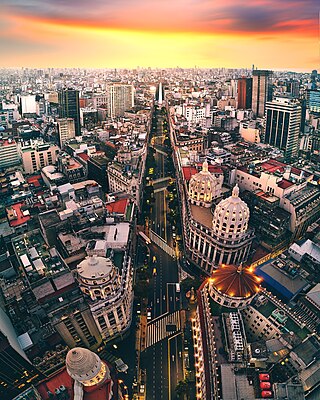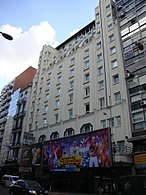
Florida Street is a popular shopping street in Downtown Buenos Aires, Argentina. A pedestrian street since 1971, some stretches have been pedestrianized since 1913.

Balvanera is a barrio or neighborhood of Buenos Aires, Argentina.

San Nicolás is one of the neighbourhoods of Buenos Aires, Argentina, sharing most of the city and national government Neighborhood of Buenos Aires with neighboring Montserrat and home to much of the financial sector. It is referred usually as El Centro, and the part east of the 9 de Julio Avenue is known as Microcentro.

Almagro is a barrio or neighbourhood of Buenos Aires, Argentina.

July 9 Avenue is a major thoroughfare in the city centre of Buenos Aires, Argentina. Its name honors Argentina's Independence Day, July 9, 1816.

Retiro is a barrio or neighborhood in Buenos Aires, Argentina. Located in the northeast end of the city, Retiro is bordered on the south by the Puerto Madero and San Nicolás, and on the west by the Recoleta.

The Abasto Shopping is one of the biggest shopping mall centers in Buenos Aires, Argentina. The building was the central wholesale fruit and vegetable market in the city from 1893 to 1984. Since 1999, it has served as a shopping mall. It is also famous for being in the area where the tango singer Carlos Gardel, known as El Morocho del Abasto, lived for most of his life. Today, the surrounding area, though part of the Balvanera neighbourhood, is sometimes referred to as Abasto.

According to the World Travel & Tourism Council (WTTC) the travel and tourism sector of Argentina was moving towards recovering its pre-covid pandemic contribution to GDP in mid-2023, led by Buenos Aires.

Avenida Roque Sáenz Peña, better known as Diagonal Norte, is an important avenue in the San Nicolás neighborhood of Buenos Aires, Argentina. It is oriented south-east/north-west, diagonally bisecting the city blocks (manzanas) which give the city centre a checkerboard plan. It is named after President Roque Sáenz Peña, who held power from 1910 to 1914 and passed the law which established universal suffrage, secret ballot and an electoral register.
There are many landmarks in Buenos Aires, Argentina, some of which are of considerable historical or artistic interest.

Avenida Santa Fe is one of the principal thoroughfares in Buenos Aires, Argentina. The artery is essential to the imaginary axis of Barrio Norte in Buenos Aires, comprising the areas influenced by the route of the avenue through Retiro, Recoleta and Palermo neighborhoods, it is considered one of the main shopping and strolling areas of the city, its many boutiques range from elegant to edgy, which has led it to be dubbed the 'Avenue of Fashion'. Upscale Alto Palermo, at Avenida Coronel Díaz, is one of the city's best-known vertical malls. Avenida Santa Fe is also an attraction for its architecture, strongly reminiscent of Paris. Its name pays homage to the eponymous province in Argentina.

Córdoba Avenue is one of the principal thoroughfares in Buenos Aires, Argentina.

Callao Avenue is one of the principal thoroughfares in Buenos Aires, Argentina.

The Buenos Aires Central Business District is the main commercial centre of Buenos Aires, Argentina, though not an official city ward. While the barrios of Puerto Madero and Retiro house important business complexes and modern high-rise architecture, the area traditionally known as Microcentro is located within San Nicolás and Monserrat, roughly coinciding with the area around the historic center of the Plaza de Mayo. The Microcentro has a wide concentration of offices, service companies and banks, and a large circulation of pedestrians on working days. Another name given to this unofficial barrio is La City, which refers more precisely to an even smaller sector within the Microcentro, where almost all the banking headquarters of the country are concentrated.

Punto Obelisco is a zone around the Obelisk of Buenos Aires and the Plaza de la República. It is a project held by the city's government in order to enrich the surroundings of the monument and to make it the center of entertainment in the city. A zone combining the theatres avenue and the lights of LED signs taking inspiration from Times Square in New York City, the Shibuya Crossing in Tokyo and Piccadilly Circus in London and runs through Avenida 9 de Julio between Rivadavia Avenue and Córdoba Avenue. It also includes a ticket sales stand.

Carlos Gardel is a station on Line B of the Buenos Aires Underground.

Del Parque is a former train station in Buenos Aires, Argentina. It was the first railway station in the country, serving as terminus of Buenos Aires Western Railway. The station was located at the intersection of Cerrito and Tucumán streets.

Avenida Medrano is an arterial road in Buenos Aires, Argentina. It was named after the politician Pedro Medrano. It runs through both the Almagro and Palermo neighborhoods. The arterial road runs northbound, with traffic going in the opposite direction. The avenue is characterized by its old banana grove, which was planted at the end of the 19th century. The trees protect the road from the sun during summer and are left completely bare after fall and during winter.

Argentine pizza is a mainstay of the country's cuisine, especially of its capital Buenos Aires, where it is regarded as a cultural heritage and icon of the city. Argentina is the country with the most pizzerias per inhabitant in the world and, although they are consumed throughout the country, the highest concentration of pizzerias and customers is Buenos Aires, the city with the highest consumption of pizzas in the world. As such, the city has been considered as one of the world capitals of pizza.

Güerrín is a pizzeria in Buenos Aires, Argentina, where the speciality of the restaurant is the Argentine pizza. Guerrin was declared by the Buenos Aires City Legislature as one of the most iconic pizzerias of the city in 2011.




























